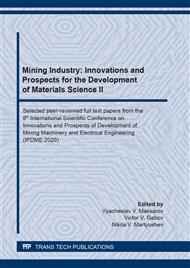[1]
M. V. Bykova, M.A. Pashkevich, V.A. Matveeva, I.P. Sverchkov, Assessment and abatement of the soil oil-contamination level in industrial areas, Topical Issues of Rational Use of Natural Resources - Proceedings of The International Forum-Contest of Young Researchers (2019) 347-359.
Google Scholar
[2]
D.Zambrano, S.V. Kovshov, E.A. Lyubin, Risk assessment of accidents due to natural factors at the Pascuales – Cuenca multiple-use pipeline (Ecuador), Journal of Mining Institute 230 (2018) 190-197.
DOI: 10.5937/jaes16-17019
Google Scholar
[3]
Mysara Eissa Mohyaldinn, Hazlina Husin, Nurul Hasan, M.B. Mohamed Elmubarak, M.E. Ahmed Genefid, E.A. Mahmood Dheeb, Challenges during Operation and Shutdown of Waxy Crude Pipelines, Processing of Heavy Crude Oils - Challenges and Opportunities, Ramasamy Marappa Gounder, IntechOpen, (2019).
DOI: 10.5772/intechopen.89489
Google Scholar
[4]
A.N. Aleksandrov, M.K. Rogachev, Thang Nguyen Van, M.A. Kishchenko, E.A. Kibirev, Simulation of organic solids formation process in high-wax formation oil, Topical Issues of Rational Use of Natural Resources, 2 (2019) 779-791.
DOI: 10.1201/9781003014638-39
Google Scholar
[5]
N.K. Kondrasheva, F.D. Baitalov, A.A. Boitsova, Comparative assessment of structural-mechanical properties of heavy oils of Timano-Pechorskaya province, Journal of Mining Institute, 225, (2017) 320-330.
Google Scholar
[6]
A. Sousa, H. Matos, M. Pereira: Modelling Paraffin Wax Deposition Using Aspen HYSYS and MATLAB. 29th European Symposium on Computer Aided Process Engineering (2019).
DOI: 10.1016/b978-0-12-818634-3.50163-6
Google Scholar
[7]
E.V. Beshagina, N.V. Yudina, Yu.V. Loskutova, Crystallization of petroleum paraffins in the presence of surface-active substances, Oil and gas business, 2 (2007).
Google Scholar
[8]
Yu.V. Ilyushin, E.I. Golovina, Mathematical analysis of high-paraffin oil temperature fields and synthesis of its control system production, Espacios, 41 (15) (2020) 27-43 ISSN 0798 1015.
Google Scholar
[9]
A.V. Kopteva, V.Yu. Koptev, V.I. Malarev, T.O. Ushkova, Development of a system for automated control of oil transportation in the Arctic region to prevent the formation of paraffin deposits in pipelines, E3S Web of Conferences 140 (2019).
DOI: 10.1051/e3sconf/201914007004
Google Scholar
[10]
I.I. Khasanov, R.A. Shakirov, A.Yu. Leontiev, O. Yu. Poletaeva, Review of modern methods of influencing the rheological properties of heavy high-viscosity oils, NefteGazokhimiya, 3 (2018).
Google Scholar
[11]
Ding li Zhang, Min Lin, A Deep-Sea Pipeline Skin Effect Electric Heat Tracing System, Energies, 12 (2019) 2466. 10.3390/en12132466.
DOI: 10.3390/en12132466
Google Scholar
[12]
M.L. Strupinsky, N.N. Khrenkov, A.B. Kuvaldin, Design and operation of electric heating systems in the oil and gas industry: a reference book, Infra-Engineering, (2015).
Google Scholar
[13]
D.Z. Valiev, R.A. Kemalov, A.F. Kemalov, Regulating temperature of oil saturation with paraffins to avoid asphaltene, resin and paraffin substances deposition during oil production, IOP Conf. Seri.: Earth and Environmental Science, 282 (2019).
DOI: 10.1088/1755-1315/282/1/012023
Google Scholar
[14]
A.V. Kopteva, V.Y. Koptev, Automatic Measuring System for Oil Stream Paraffin Deposits Parameters, IOP Conf. Ser.: Materials Sci. and Engin., 327, 4 (2018).
DOI: 10.1088/1757-899x/327/4/042053
Google Scholar
[15]
I. M. Astafieva, D. N. Gerasimov, R. E. Makseev, Density measurement by radiometric method with gamma irradiation from sources of low activity, IOP Conf. Series: Journal of Physics: Conf. Series, 891 (2017).
DOI: 10.1088/1742-6596/891/1/012322
Google Scholar
[16]
J. Hoffmann et al., Safety testing and operational procedures for self‐developed radiofrequency coils, NMR in Biomedicine, 29 (9) (2016).
DOI: 10.1002/nbm.3290
Google Scholar
[17]
E. Yousif Mahmoud, The Compton Effect Re-Visited, Journal of Advanced and Applied Physics. Adv Appl Phys, 13 (2016).
Google Scholar
[18]
J. Sobota, V.I. Malarev, A.V. Kopteva, Calculation of oil-saturated sand soils' heat conductivity, Journal of Mining Institute, 238 (2019) 443-449.
DOI: 10.31897/pmi.2019.4.443
Google Scholar


